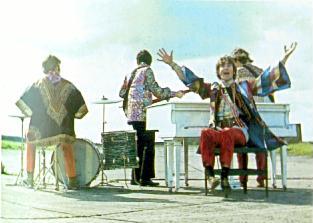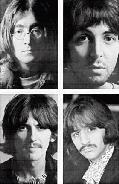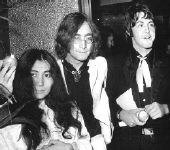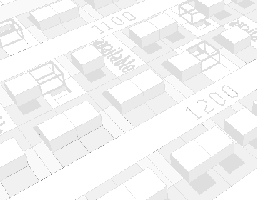
Roll Up For The Mystery Tour!
1967 - 1970

A New Fan's Guide To The Beatles
Please be patient while Beatle pics and sounds load. It takes a while, but it's worth it!


A New Fan's Guide To The Beatles
Please be patient while Beatle pics and sounds load. It takes a while, but it's worth it!
With touring over (their last concert being at Candlestick Park in San Francisco on August 29, 1966), The Beatles concentrate on creating new sounds and colors in the studio. This is the Strawberry Fields Forever/Penny Lane/Sgt Pepper/ Magical Myster Tour era that has influenced so many bands in the '90s. Put on those love beads, burn that bra, turn out the light and turn on the lava lamp (or just turn on), and you are now in the mood to listen to:

This is an amazing era, both for The Beatles and for the American Culture. It was the Summer of Love. The Beatles new look of moustaches and wild, colorful clothes shocked us all and we knew we were in for a special treat the moment we saw the then-strange cover of Sgt. Pepper. Remember that this was the time when hair was getting longer and the anti-war movement was in full swing. Incense and marijuana filled the air, and The Beatles were leading the way with some of the most amazing music of the decade.
"Strawberry Fields Forever" and "Penny Lane" were the first two songs recorded for the new album, which was originally to be centered around their childhood and growing up in Liverpool. This concept quickly ended when Capitol needed a new single and SFF/PL was released before the album was complete. George Martin later regretted not putting these two songs on the final album.
Besides all the strange new sounds - and if you wern't there, believe me when I tell you that hearing an oboe on "When I'm 64" or the animal sounds on "Good Morning, Good Morning" or the orchestra cresendo on "A Day In The Life" was mind-blowing! Never before done on one album! If anyone doubted if The Beatles could go on after touring stopped, this album proved them wrong.
 |
This was also the era of the Maharishi and their famous trip to India. Brian Epstein, their long time manager, committed suicide around this time, depressed that The Beatles no longer seemed to need him. To rebound from his death, Paul coaxed the others to make a new film, "Magical Mystery Tour". Considered by most at the time to be their first big flop, it is interesting and enjoyable to see it today. Very amateurish at times, the music stands up today and many of the images (the "I Am The Walrus" scene where they play the song with their masks on) are classic. |

Hey Jude and Revolution single. White Album. What more can you ask for? Pick them both up and follow along. The "Yellow Submarine" movie is no longer sold but often available in video stores. This movie has held up better than HELP! and must be seen to be appreciated. I recommend you spend any free time you have this month searching out the video. Listen carefully to stripped down version on Anthology 3 after you have heard the original tracks to fully appreciate the production of the final songs.
To further get into the mood, I suggest you do the following activities:

"All You Need Is Love" was broadcast to the world on June 6, 1967. The backing track were prerecorded (to ensure that nothing went wrong) but the vocals, bass, drums, guitar solo and orchestra were "live". Another first for The Beatles. They were riding so high at this point that they could even come out looking good when they wern't trying - "Yellow Submarine" was one of the last projects Brian started before he died. To provide the contratual third movie to United Artist with minimal involvement from The Beatles themselves, the animated movie idea was born. The Beatles cared so little about this film that they only donated leftover (and previously rejected) songs for the soundtrack. But the movie was a hit nonetheless, and The Beatles were quick to smile for the cameras and take their credit.

The Beatles were beginning to unravel at this point. It is well documented that the White Album sessions were less than friendly. Ringo quit the band during this period (but was coaxed back in after they smothered his drums with roses), John was bringing his new love, Yoko, with him to the studio (which upset the other three), Paul was accused of being too controlling (nothing new here), and George was beginning to work with other musicians (the soundtrack Wonderwall, playing with Clapton, etc.). This makes it even more amazing that the Fab Four could still produce classic Beatle music - even when they didn't particpate on each other's tracks.
McCartney would soon be accused of singing sappy songs with Wings, but what makes songs like "Martha My Dear" or "Honey Pie" classic Beatles instead of silly love songs? Why are those songs "better" than "Uncle Albert" from RAM or "Hope and Deliverance" from OFF THE GROUND? The answer is that every Beatle song had something that the solo material would never have..... Beatle "magic". If this sounds trite and silly, then ask yourself what made "Free As A Bird" and "Real Love" work so well?
But Beatle magic would not last forever. Once the White Album was finished, The Beatles embarked on the long and winding road to the end. It was almost over, and the beginning of the "Get Back" film project.

While the "Let It Be/Get Back" sessions occurred right after the "White Album" sessions, it wasn't released until after Abbey Road. To get the best Beatle experience, now is the time to purchase Abbey Road and listen. Notice how George, who had been quite vocal about his distaste of the pop direction of Paul, had ironically written a beautiful McCartneyesque song with "Something". John's classic "Come Together" gave us more of his famous convoluted lyrics, and "I Want You (She's So Heavy)" is so heavy that there's just one line of lyric amidst all the sounds and noise. Another advant garde song set in a very commercial mode. Abbey Road is for many The Beatles at their peak - and represents the final performances as a band (though technically they went back to the studio to clean up some of the songs for "Let It Be").
But we're getting ahead of ourselves. The "Get Back" story is a long one and documented in many Beatle books. The short version of the story is that Paul, sensing the band was falling apart, wanted to "get back" to their roots and make a movie of them doing a huge, live concert. The thrill of a live audience was what was missing, thought Paul, and this might be the thing to get them to work together again. They began rehearsing with the cameras and recorders rolling, hoping to include some footage on how the live show came to be. But rehearsing in front of cameras and lights early in the morning was not popular, and all four Beatles soon began to hate these sessions. And, since they had just released the White Album, they had barely enough time to create new music. The "big concert" idea was finally scrapped in favor of a rooftop show. The live show was filmed (which was technically their last concert) and the tapes were shelved.
It wasn't until after Abbey Road that Lennon gave the tapes to friend Phil Spector. If you have heard any of the bootlegs or tracks off Anthology 3, you know that Phil didn't have a lot to work with. Nonetheless, he either salvaged a Beatle album out of the bottom of the Beatle barrel or ruined the beauty of the raw tapes, depending on who you talk to. John wanted to smash the Beatle myth and release an early version of the tapes produced by John Glynns. Available on bootleg, this early version showed us The Beatles at their worst. Off key, wrong notes, uninspired playing, and below-average songs. Beatle fans today love listening to these strange tracks, but if released at the time it would have made the "Magical Mystery Tour" movie look like "Citizen Kane".
Phil took his liberties with the tapes, adding strings on "The Long and Winding Road" to hide the fact that this was little more than a demo or rehearsal, cutting up "Get Back" to make it sound like the live rooftop performance, and adding the syrup to "Across The Universe". Thankful we should all be that Anthology 3 gives us some of these recordings "as nature intended", to quote the original Beatle album.
Let's get back to Abbey Road. Originally to be titled "Everest" with a picture of the fabs standing in front of Mt. Everest, it became "Abbey Road" once the boys decided it would be significantly easier to just go outside for the picture. The album is a gem. I still remember listening to my transistor radio tuned to KFRC in San Francisco as they played each and every song. The long medley on "side 2" was Paul's attempt to salvage all the unfinished material they had been working on. (That's why you can hear them rehearsing songs like "Mean Mr. Mustard" on the "Let It Be" bootlegs.) How amazing they could pull out of the dead feel of the "Get Back" sessions and shine as bright as they ever would on "Abbey Road". Confident, polished and well executed, this is the final album and the peak we had all anticipated since we first heard "Love Me Do".
Once you have marvelled at Abbey Road, put on the "Let It Be" video if you can find it or watch the last tape of Anthology. "Let It Be" has been described as a "cardboard tombstone", the sad ending to the greatest rock band ever. Today, of course, you can listen to it for what it really is - a historical recording of the down era before Abbey Road. And while some may discard the album as one of their least significant, remember that this album contains "Let It Be", "Get Back", "Across The Universe", and "The Long and Winding Road" - all classic Beatle songs.
To end your journey, play the rooftop tracks from Anthology 3 and the "Let It Be" album one after another. Even in the Beatle's darkest hours, the sound of Paul and John singing together lifts the heart. Listen to "I Me Mine", the absolute final recording session (before Anthology, that is) and notice that John is absent from the recording. And now, get your hankies ready and put on both the Anthology version and the final version of "The Long and Winding Road". Listen as Paul sings at the end "yeah yeah yeah, yeaahh" - have we heard that somewhere before, in another time and another place?
But before we end the show, program your CD player with the following tracks:
Close your eyes as the orchestra swells around you on the final bars and the beautiful harmonies of John, Paul and George fills the air.
And so ends your journey. The most amazing thing about the Beatles is that it all happened so fast - from 1964 (America) to the end of 1969. Beatle songs were everywhere back then and a new single or album was never more than a few months away. Little did we know back when the needle lifted off the final groove of "Get Back" ("I hope we passed the audition...") that we would have to wait eight more years for the next Beatle release ("Live At Hollywood Bowl"), then 15 more years after that to get BBC & Anthology. As a new fan who can just go out with your credit card and buy it all today, I hope this little tour of the Beatles has shed a little light on what Beatlemania was all about.
Why Travel To Other Sites? Trust Your Pepperland Tour Guide!
Home
Beatle Bytes
Collecting on a Budget
In My Life
Imagine This! Beatles in the '70s
Beatle Survey and Guestbook
 Get your own Free Home Page
Get your own Free Home Page